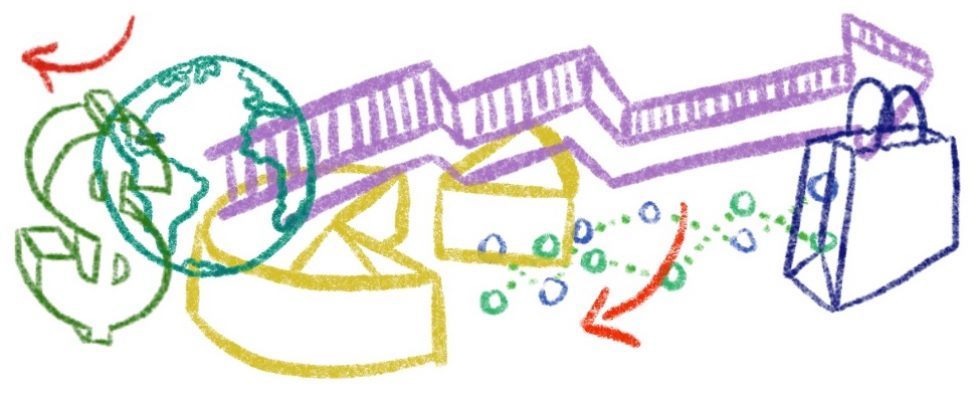Profit
Among the four pillars, profit draws attention to the fashion industry’s revenue. Recent events required sustaining a thriving business through unstable times, rethinking business models, and examining the art director’s role as they navigate the changing market.
According to IBIS World (2022), the size of the manufacturing industry alone reached more than 850 billion dollars in 2022. Statista (2021) stated in a recent report that “The revenue of the global apparel market was… 1.5 trillion U.S. dollars in 2021.” Mintel (2022) also shared that the luxury market stands at more than 270 billion euros in 2022.
When examining sector performance, McKinsey (2022) discusses the luxury sector’s resilience as the pandemic less affected most of their customers, “whose funds saved on travel and entertainment were reallocated towards luxury goods” (p.119). Additionally, sportswear was another sector that showed significant growth, as the pandemic led to consumers’ change in focus that “accelerated existing strengths in sportswear, athleisure and outdoor brands” (p.118).


However, other sectors saw earnings drop and fall in revenue. Due to the extensive lockdowns and the dependency on sales from physical stores, the value and discount players saw earnings decline (McKinsey, 2022). “Shoppers also shifted some of their spend on clothing to essential retailers such as grocers” (p.119). With the consequences of lockdowns, these notions also resulted in mid-market fashion players not fully recovering like the rest of the industry.
McKinsey (2022) states that the next two years appear more favourable for the global fashion industry. Nonetheless, “the shakeout is not over as weaknesses exposed during the Covid-19 pandemic will continue to plague the industry” (p.121).
As the market is inherently competitive during steady and challenging times and staying relevant is more complex than ever, decision-makers should consider measures to sustain growth while handling recent supply chain difficulties. Correspondingly, embracing business models suited for accelerated transitions in consumer behaviour can make a fundamental difference, as the players practising them are being rewarded (McKinsey, 2022).
While creative directors used to align themselves with art over commerce to benefit financially, the matter is different nowadays. Modern times illustrate creative directors as suppliers of aesthetic experiences while leading brands to financial profit as they develop their unique markets and attempt to infiltrate new ones, bridging the worlds of art and commerce (Stevenson, 2019).

The creative director leads the design stage, where crucial decisions affecting the supply chain are made (Gwilt, 2020). From selecting materials to deciding the design method and considering circularity or even collaborations, designers face determinations affecting the brand’s creative ethos and financial success. It is also required that designers beneficially spread the label’s message to their target audience as public figures (Mitterfellner, 2019).
Reference list
DeZeen (2021). Available at: https://www.dezeen.com/2021/11/29/virgil-abloh-design-roundup/ (Accessed: 23 October 2022).
Gucci (2022). PALACE GUCCI. 14 October. Available at: https://www.youtube.com/watch?v=awdE7dF672I&ab_channel=GUCCI. (Accessed: 23 October 2022).
Gucci Vault (2022). Available at: https://vault.gucci.com/en-US/story/enter-vault (Accessed: 23 October 2022).
Gwilt, A. (2020). A Practical Guide to Sustainable Fashion. London: Bloomsbury Publishing USA. Available at: https://ebookcentral.proquest.com/lib/ual/reader.action?docID=6234061 (Accessed: 23 October 2022).
IBIS World (2021). Global Apparel Manufacturing- Market Size2005–2027. Available at: https://www.ibisworld.com/global/market-size/global-apparel-manufacturing/ (Accessed: 23 October 2022).
Mintel (2022). Luxury Goods Retailing – International – 2022. Available at: https://reports-mintel-com.arts.idm.oclc.org/display/1159687/ (Accessed: 23 October 2022).
Mitterfellner, O. (2019). Fashion Marketing and Communication: Theory and Practice Across the Fashion Industry. Taylor & Francis Group. Available at: https://ebookcentral.proquest.com/lib/ual/detail.action?docID=5981798 (Accessed: 23 October 2022).
Statista (2021). Apparel Market Worldwide. Available at: https://www.statista.com/topics/5091/apparel-market-worldwide/#dossierKeyfigures (Accessed: 23 Oct. 2022).
Stevenson, C. (2019). ‘(I Was There) When It All Went Down’, Vestoj, Issue 9: On Capital.
The Business of Fashion and McKinsey & Company (2022). The State of Fashion 2022. Available at: https://moodle.arts.ac.uk/pluginfile.php/1463744/mod_label/intro/The_State_of_Fashion_2022.pdf?time=1664132324542 (Accessed: 23 October 2022).
Vogue (2021). Available at: https://www.vogue.co.uk/fashion/article/balenciaga-spring-2022 (Accessed: 23 October 2022).
Vogue (2021). Available at: https://www.vogue.com/article/demna-gvasalia-brings-haute-couture-back-to-balenciaga (Accessed: 23 October 2022).
